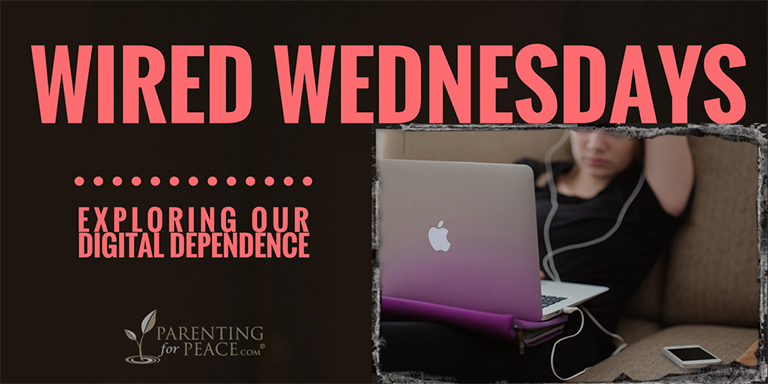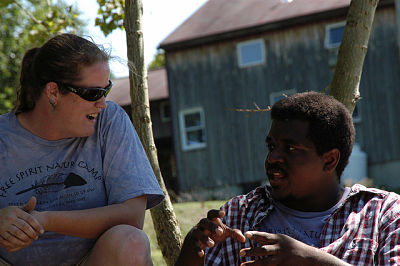![]()

![]()
Is our technological wizardry with its infinite stream of instant answers eroding what makes us most human? Is digital dependence undermining our social intelligence?
During my strolls through Costco, a persistent thought comes to me (besides yum, those pizza samples are good): If I were an evil genius wanting to erode the nutritional intelligence of a civilization, this would be a good first step: induce mass consumer hypnosis via the big-box store. (Will return to this point in a bit.)
During my infrequent strolls down streets with actual pedestrians, a persistent question comes to me: How will our culture’s mass digital dependence affect this generation’s social intelligence?
In the half-decade between my son’s junior year and my daughter’s freshman year in high school, I witnessed Ian’s late-night telephone confabs (on a landline, gasp, when conference calls were a cool innovation) give way to Eve’s disembodied “connectivity” with Facebook friends. This glaring (de?)evolution announced itself through our walls: where there was once the sound of my son’s human voice — expressing the dynamic range of emotions endemic to the adolescent — now there was… silence. Save for some tapping on the keyboard and an occasional giggle or groan from my daughter as she digested the latest posts.
The Disconnect Between Social Media and Social Intelligence
Now just hold on there before you brand me one of those stuffy oldsters (I’m not that old) pining away for a nostalgic, over-romanticized past. Many thoughtful people have studied this area and harbor similar concerns. Social Intelligence author Dan Goleman cautions, “This inexorable technocreep is so insidious that no one has yet calculated its social and emotional costs.” In my book Parenting for Peace I point out,
Humans are biologically designed to be in physical proximity to one another as a way of mutually regulating our inner physical and emotional states. But 21st-century technologies seem intent upon prying us apart with the allure of awesome gadgets that are, ironically, designed and perceived as ‘connecting’ tools. In today’s iTwitterFaceLinkInPod world, blogging, texting, IMing and tweeting are today’s accepted modes of ‘reaching out and touching’ one another, yet studies have found that people become more depressed and lonely the more time they spend “interacting with others” online!
 The past few years we’ve seen a lot of research come down the pike about the impact of social media on psychological wellbeing. It’s been fairly conclusive that it is negative; indeed, the newest, most rigorous study yet confirms that the more time we spend on Facebook, the unhappier we are.
The past few years we’ve seen a lot of research come down the pike about the impact of social media on psychological wellbeing. It’s been fairly conclusive that it is negative; indeed, the newest, most rigorous study yet confirms that the more time we spend on Facebook, the unhappier we are.
William Falk, editor-in-chief of my favorite news digest The Week, muses that for his daughters, “nearly every waking moment holds the possibility of a status update, a text, an IM, a YouTube link, or other communication from the matrix.”
Falk reflects on his own life at that age, hours of which were spent outdoors in whirls of physicality, face-to-face with his buddies and flirting with girls, or alone in his room ruminating on everything and nothing — in the kind of open-ended thought stream of nothing-in-particular (“mindlessness”) neuroscientists now recognize is as important to the health of our social brains as mindfulness.
Falk is wistful: “Now that their laptops and their smartphones are always pinging, there is less time for that. Someone somewhere always has something to say.”
But we aren’t really saying these somethings to each other — at least in the way that our social brains really get.
Here’s the conundrum, particularly for parents hoping to foster vibrant social intelligence in their children: while technology has careened forward and changed our world dramatically, even in just the past twenty years, human beings haven’t much changed — in how we’re built or how we function — in thousands of years.
We’re essentially running hypermodern software programs on hardware that wasn’t built for it!
What was our hardware built for? And by hardware, I mean our incalculably wondrous brains, brains with the capability to conceive computers in their own image?
How Do We Really Communicate?
 Our brains… our nervous systems… our entire beings… were built for human-to-human connection. We transmit mental states and moods wordlessly, we soothe physiological distress simply through our presence, we convey and receive volumes of critical human data through real-time facial micro movements, through vocal tone, volume, pitch, and pace. It’s our humanity, silly!
Our brains… our nervous systems… our entire beings… were built for human-to-human connection. We transmit mental states and moods wordlessly, we soothe physiological distress simply through our presence, we convey and receive volumes of critical human data through real-time facial micro movements, through vocal tone, volume, pitch, and pace. It’s our humanity, silly!
Only seven percent of our communication is the actual words; ninety-three percent is body language, eye movement, vocal inflection and intonation (prosody) and other non-verbal data. That’s a lot of heavy lifting for an emoticon. 😕
Your Kids Are Watching and Learning…You!
The infrastructure for our social intelligence gets downloaded from parents (or other caregivers) to infants and young children, and make no mistake: it is a human-to-human situation, and it relies on the adult as the model. “Hands Free Mama” Rachel Macy Stafford really gets it:
If I want my children to appreciate the joy of a screen-free Saturday afternoon in the future, I must take time to show them the joys of screen-free Saturday now. If I want my children to look directly into the eyes of those who speak to them when they are adults, I must look into their eyes and listen to their words now.
Indeed, the most potent mode of learning for children of all ages (and adults as well) is imitation. Waldorf early education teachers have long known this, which is why they convey through their own speech and actions an atmosphere worthy of the child’s unquestioning imitation.
Partly for this reason — that children learn and wire their brains based on models — Waldorf teacher Carol Toole raised a concern about electronic playmates for children. Ironically, this was almost fifteen years ago, before the massive proliferation of screen-based “learn to read” programs for every age including infants.
Toole points out how electronic interaction undermines the central need of children to learn in the context of relationship and imitation:
The budding orator needs to hear speech that bears the undivided attention, enthusiasm, and interest of the speaker. Studies reveal that language experienced via television or other electronic media does little to increase a child’s vocabulary. Such disembodied speech does not nourish the child in his learning to speak. Even the speech of real and present people, when it is curt and clipped and seeks only to convey information, does not truly nourish.
So Carol, try this on for size: a 90-second home video of a little boy trying his best to have a meaningful conversation with Siri:
In Our Own Image?
Imagine you just dropped down from another planet, after receiving a primer on how humans interact with each other (e.g., they adjust their choice of words and vocal inflection based on the other’s questions) and you encountered Siri. A bit of a head-scratcher, doncha think?
William Falk asks if it’s “silly and backward to wonder how the onslaught of nonstop input — most of it trivial — is altering how we think?” He cites research showing that the intricate “mental maps” people made before the advent of GPS utilized a region of the brain that actually grows with use… and shrinks without use. Less actual gray matter.
“If we rely on Facebook et al. as an interface with reality,” Falk wonders, “what withers? What shrinks?”
If I were an evil genius wanting to erode the social intelligence of a civilization, this would be a good first step: induce mass relational awkwardness via Siri.
Done and done.
Images:
Steinar Engeland on Unsplash
pseudoplacebo | Creative Commons license
bonbon11ful | YouTube
Sources:
Goleman, Daniel. Social Intelligence: The New Science of Human Relationships. New York: Bantam/Dell, 2006, pg. 7. • Lewis, Thomas, Fari Amini, and Richard Lannon. A General Theory of Love. New York: Random House, 2000. • Harmon, Amy. “Researchers Find Sad, Lonely World in Cyberspace.” New York Times: New York Times Company, 1998. This article details the first such study; many have been done since, and they have reached similar conclusions—that the more time someone spends online, the less happy and more depressed he or she is likely to be. Just two hours of surfing the net per week was associated with various forms of anxiety & depression, leading to reclusiveness, and feelings of alienation. And, they were passionate consumers! • Christakis, Nicholas and Shakya, Holly. “A New, More Rigorous Study Confirms: The More You Use Facebook, The Worse You Feel.” Harvard Business Review, April 10, 2017. • Falk, William. “Editor’s letter.” The Week, The Week Publications, NY. February 17, 2012, pg. 5. • Badenoch, Bonnie. “Mindfulness/Mindlessness.” YouTube, www.youtube.com/watch?v=pbyTRSnwhsI. “Mindlessness,” a state when the mind “lets go,” relies on the newly recognized default network in the brain; notable discoveries, inventions, and works of creativity have arisen from this state. • Toole, Carol. “The First Four Years of Childhood.” Renewal: A Journal for Waldorf Education 11, no. 1 (2002): 5-9.
![]()
![]()
Tags: Dan Goleman, depression, digital-dependence, Facebook, handheld devices, Siri, smartphones, social intelligence, social media, technology, teens, William Falk


